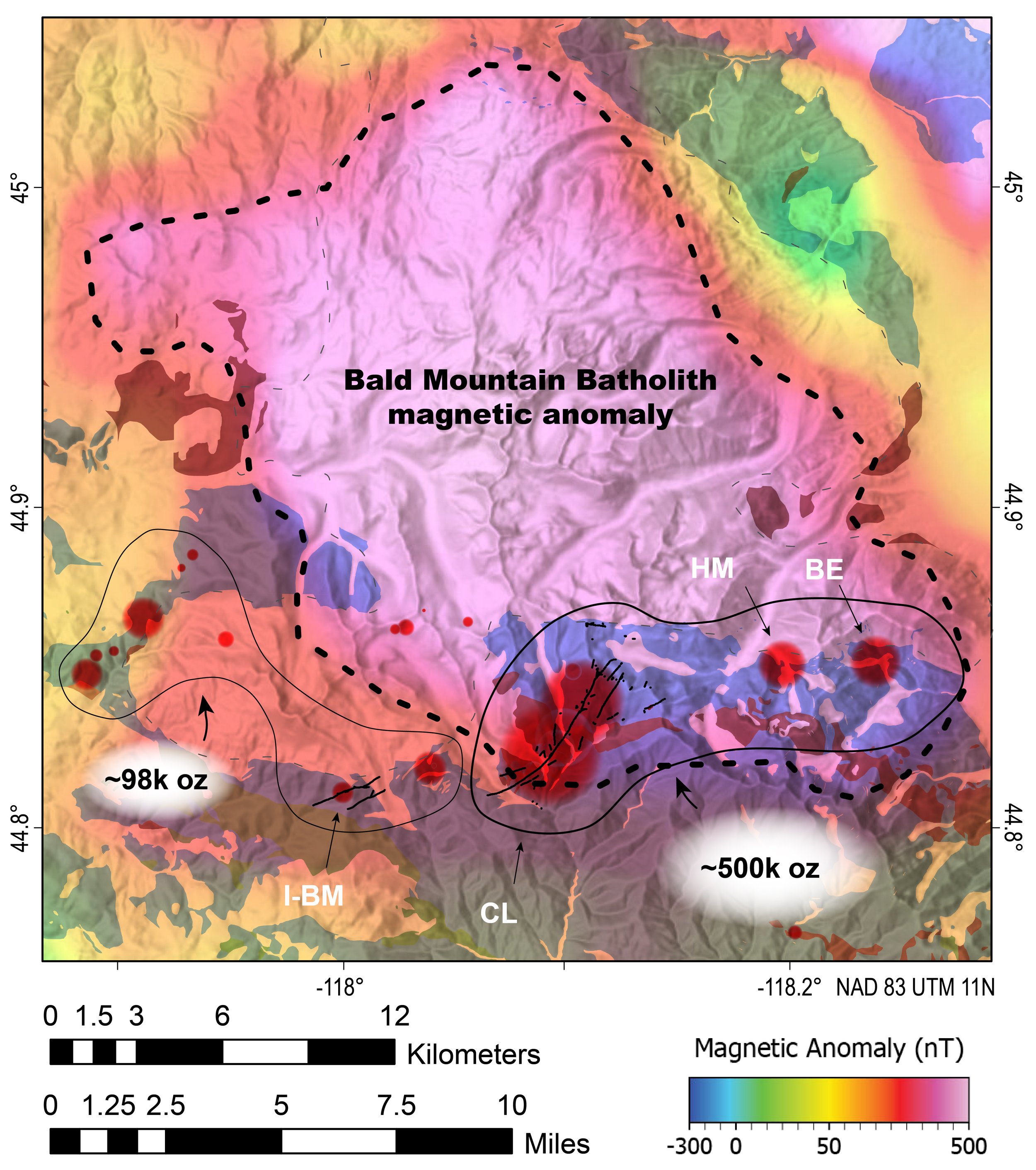This work was published in Ore Geology Reviews in early 2023. Check it out here: Orogenic gold in the Blue Mountains, eastern Oregon, USA - ScienceDirect
Also the PDF here: Orogenic gold in the Blue Mountains, eastern Oregon, USA | Elsevier Enhanced Reader
Western North America
contains a belt of Late Jurassic-Early Cretaceous orogenic gold deposits mainly hosted within the “Intermontane Terrane Group”, which includes the Sierra Nevada Foothills, Klamath Mountains, Blue Mountains, and Quesnelia-Barkersville Terranes, BC.
Map showing the distribution and endowment of orogenic gold deposits within the Blue Mountains Gold Belt. BMB: Bald Mountain Batholith
The main conclusions of this study are:
Orogenic gold in the Blue Mountains of eastern Oregon is predominately hosted in marine metasedimentary rocks that comprise an accretionary wedge sandwiched between two magmatic arcs.
Gold mineralization is linked spatio-temporally with the collision of these two arcs, obduction of accretionary wedge, and with left-lateral oblique convergence along the NAM continental margin
The most well-endowed lodes trend NNE-SSW and dip steeply to the ESE.
The well-endowed lodes are likely left-lateral strike-slip faults that partitioned the oblique component of Farallon-NAM convergence, but also may have formed due to pre-existing structures along the margin (e.g., Columbia Embayment)
At the district to deposit scale, well-endowed segments of lodes represent dilational jogs within the left-lateral kinematic framework.
The Cracker Lode, in particular, resembles a pull-apart basin, with N-directed bends in the NE-trending lode clearly being the richest parts with abundant secondary structures to accommodate the dilation.
A timeline of major mineral system phases and associated structural and magmatic events.
Arc-arc collision
resulted in accretion of marine metasedimentary rocks (blue) between two island arcs, the Wallowa and Olds Ferry Terranes.
Argillite and schist within the accretionary wedge host some 60%-70% of orogenic gold in the region.
Well-endowed lode gold is spatially associated with major plutons intruded near crustal-scale, terrane-bounding faults. This figure is modified from Schwartz et al. (2014).
Pie diagrams
showing gold production by host rock (top) and by mine site (bottom). Note the majority hosted by argillite and schist (top) and the major contribution by the Cracker Lode deposit (bottom).
Exposure of orogenic gold deposits is likely controlled by Neogene folds and faults that uplifted the Blue Mountains. These folds may have reactivated pre-existing fold related to the Mesozoic accretion.
This longitudinal section of the Cracker Lode system suggests ore shoots follow lines parallel to vein-secondary vein intersections and vein-foliation plane intersections.
Vein endowment
as a function of strike azimuth (top) and dip (bottom). Very steep dips are apparently better, supporting the notion that the veins are predominately strike-slip faults (see below).
A Circular Histogram
weighted by endowment (top) supports that well-endowed lodes trend NE-SW.
Contoured maximum stress vectors (Ave Lallemant, 1995), combined with 1) evidence of left-lateral slip along the Cracker Lode (see below), 2) contemporaneity with the early phase of Sierra Nevada Foothills / Klamath Mtns gold, and 3) relative plate motions in Late Jurassic-Early Cretaceous times support left-lateral oblique convergence and a stress field like the one shown in the combined circular histogram - spherical projection.
The extension direction
calculated from surface and underground joint measurements generally supports local E-W extension and N-S compression, loosely consistent with the paleo-stress field above, with some caveats in terms of the least and intermediate stresses.
This orientation map is an interpolation of dispersed bedding measurements within the Elkhorn Ridge Argillite. The map resolves two NW-SE - trending synclinal fold axes that are offset by ~ 500 m along the Cracker Lode. Offset is left-lateral.
Reconstructed NAM margin and stress field
support left-lateral kinematics on (presently) NE-SW oriented lodes. The Blue Mountains composite terranes were rotated about a vertical axis by ~60° since ca. 120 Ma. Reversal of this rotation suggests the left-lateral lodes actually trended NNW-SSE and may have formed due to the presence of an embayment in the margin and/or due to slip partitioning along the obliquely-convergent margin.
The latter interpretation is consistent with the modern analog of the Sumatra Margin (bottom map to scale with top), where orogenic and epithermal gold deposits are localized along the strike-slip fault that is sub-parallel to the trench system and subduction zone.
Margin-parallel strike slip faults
provide a crustal-scale magma and fluid-plumbing system that transports Au-rich fluids from the dewatering slab and mantle wedge to crustal reservoirs
Host rock characteristics
Field observations and core logging
reveal patterns in the argillite host rock and vein kinematics. The host rock is dominated by interbedded strong and weak units with different structural and hydrological anisotropy.
Fault grooves and hematite-coated slickenlines support left-lateral, oblique-normal slip on the Cracker Lode, consistent with several other independent lines of evidence.
V-rich alteration assemblage to the bottom right and bedded pyrite on bottom left
The reactivity (R)
of the host rocks was calculated from portable XRF scans of core and coarse rejects from core logging. The high reactivity indicates that the argillite around the Cracker Lode was pre-conditioned to form sulfides and host gold deposition due to high Fe content.
Geomechanical and hydrological
contrasts within the argillite (especially in the Cracker Creek area) likely facilitated trapping of auriferous fluids, localized brecciation, and continues, repeated gold-qtz vein mineralization during fault slip events.
We propose this basic genetic model at the deposit scale that may help explain ore shoot pitch variations (see also long section above).
Well-endowed lodes
around the Bald Mountain Batholith have strike azimuth subparallel to its boundaries but also seem to have formed within a roof pendant that overlies a strongly magnetic part of the batholith.
Within the left-lateral kinematic framework, dilatant zones form where ENE-trending strike-slip lodes bend to the N. The Cracker Lode (most productive deposit in the region) provides a good example. The well-endowed part resembles a “pull-apart” structure where strike-slip movements would create space locally for Au-rich fluids to infiltrate.


















